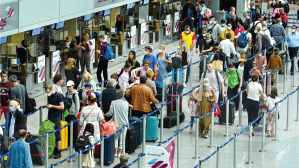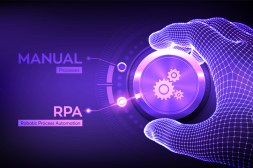Federal agencies are very pleased with process robotics — but it’s early days still

Many federal agencies are very happy with their (digital process) robots.
This was the overarching impression left by enterprise robotic process automation (RPA) provider UiPath’s inaugural federal user conference, UiPath Together. The event Tuesday featured a veritable parade of speakers from customer federal agencies, each speaking, sometimes quite granularly, about how RPA is being used at their agencies, how the projects got started, what challenges they’ve faced and more.
But there’s an important caveat to note here too — most of these use cases are still quite new. Ed Burrows, senior adviser to the CFO and the General Services Administration, delivered this consumer warning, of sorts, at the start his keynote. “My presentation is very positive,” he told the gathered crowed. But it’s early days — “just to let you know, we’re in the honeymoon period,” he added.
Burrows said the RPA project being run in his office is projected to have a huge return on investment in terms of employee work hours saved. And he’s not the only one excited about the potential — when the office looked for volunteers to test the software, it received 45 applications, ultimately choosing 10 to partake in an initial online training, Burrows said.
GSA wasn’t the only happy customer at UiPath Together. The U.S. Postal Service is also running an RPA pilot that Maura McDevitt, the agency’s controller, came to talk about. The bot, which was launched in January, collects missing information about packages four times as fast as a human worker can.
Over at the Defense Information Systems Agency, leaders held a “race the bot” challenge in the office — pitting a new bot (pilot launched in December 2017) against an experienced and talented human employee. In 15 minutes, Chief of Accounting Operations and Compliance Division Barbara Crawford said, the bot was able to pull 150 relevant accounting documents while the human was able to pull just two.
“The whole team is so energized and excited,” Crawford said.
Brian Reid, representing NASA, spoke briefly about George Washington, the federal government’s first bot.
The event heavily skewed toward speakers on the finance and business side of the agencies rather than IT. McDevitt from USPS said she chose to run the bot pilot in her office because the process the bot is automating is a central business process, not an IT process. That said, she added, it’s important that IT and security be involved.
This wasn’t the only piece of advice meted out Tuesday.
It’s comforting, when trying something new, to know you’ve got a few friends who have walked a given road before. And this, it turns out, applies just as easily to deployment of RPA software in the federal government as it might to various personal life milestones — much of UiPath Together resembled a live-action advice column: Get leadership support, speakers advised. Start small! And whatever you do — don’t automate a fundamentally bad process. Because despite all the promise of RPA, Burrows quipped, you wouldn’t want to end up “freeing people up to find more things to do inefficiently.”
Artificial intelligence and machine learning, of which robotic process automation is one early stage, were part of FedScoop’s top emerging technologies of 2018 list.






